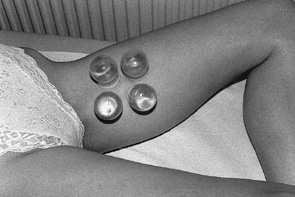Reproductive Organs
Female Reproductive Organs
Menstrual Disorders, Inflammations of the Reproductive Organs
All healthy women menstruate during their fertile years. The time between the first and last menstrual period spans ~30–40 years. During this time, typical repeated changes occur in the endometrium and the menstrual period returns regularly, according to a cycle of roughly 4 weeks.
The processes in the female organism by no means always pass without mishaps. Some women experience discomfort when menstruating, suffering from cramps, headache, and other symptoms.
The female menstrual cycle is one of the best examples for the complicated interrelationships between different hormones. The entire endocrine system is involved. Furthermore, other organ systems must also function correctly to ensure that the cycles proceed normally. Diseases of the thyroid gland, for example, cause menstrual irregularities or even a complete absence of menstruation. The activity of the ovaries, which determines menstrual bleeding, is not always stable. Stress, mental strain, even just a change of surroundings or jobs, extremely high or low weight, certain medications, and infections or other diseases are only some of the many factors that can disrupt a woman’s reproductive cycle.
The strength and duration of menstruation, but also the type of pain, provide clues about both healthy as well as disturbed activities of the female organs.
 Any unresolved menstrual irregularity must be examined by a specialist.
Any unresolved menstrual irregularity must be examined by a specialist.
Inflammatory diseases of the ovaries and uterus are also responsible for menstrual irregularities. The causes for these diseases are mostly infections that ascend from the vagina upward, and in addition, for the uterus, inflammations that descend from the fallopian tubes and ovaries.
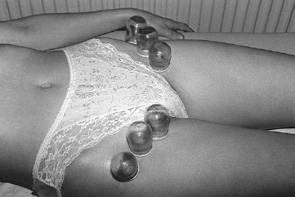
Fig. 12.1 Dry cupping in the groin over Head’s zone for the uterus and adnexa.
Symptoms
• Feeling of pressure in the lower abdomen, labor-like pain, menstrual disorders.
• Often fever, occasionally with sudden attacks of shivering.
• After the cause has been determined, cupping can lead to fast results, also in combination with measures from conventional Western medicine.
Cupping can be applied with good results in all gynecological diseases listed below (Figs. 12.1–12.3).
• Adnexitis, endometriosis:
– Treatment initially occurs in intervals of 7 days, ca. three treatments; afterwards, in intervals of 14 days, approximately also three treatments.
– Additional measures in consideration of the stage of the disease and the situation of the patient.
Fig. 12.2 Dry cupping on the inside of the thigh. According to acupuncture theory, connections exist to the inflamed genitalia.
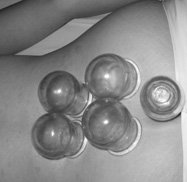
Fig. 12.3 Dry cupping on both sides of the spinal column in segments L1–L5.
• Amenorrhea, hypermenorrhea, menorrhagia, dysmenorrhea:
– In these conditions, continue treatment in intervals of 10 days for 3 months. Afterwards, treatment depends on the development of the disease.
– If therapy is continued, keep treating in larger intervals of 3–4 weeks.
See Fig. 12.8, p. 125.
Supplemental Therapy
• For inflammations, bedrest can be useful.
• Homeopathy. Homeopathic treatment of any of these diseases generally achieves good results. In these cases, organotropic and functiotropic remedies are indicated, but the therapist must, as so often, choose among a large number of remedies.
• Physical therapy. Cold or warm compresses; sitz baths can complement the treatment and accelerate recovery.
• Phytotherapy. Extracts that have a sedative and spasmolytic effect (lemon balm, yarrow).
Alternating Therapy
• Neural therapy. Quaddle therapy with local anesthetics on top of the ventral Head’s zones of the lower abdomen and on top of the sacrum.
• Autohemotherapy. Autohemotherapy is indicated.
• Baunscheidt therapy. For detoxification and promotion of autoimmune resistance, it can be useful as alternating therapy.
Climacteric Disorders
Menopause, also called “climacteric period,” is the stage in a woman’s life when ovulation and menstruation cease and hence the years of fertility end.
The biological effect of menopause is a process that extends over 5–10 years, during which the activity of the ovaries drops off and then stops altogether. It is important to remember that a natural menopause, in contrast with a surgically induced one, is not a disease but a biological process that can be divided into three stages: premenopause, menopause, and postmenopause.
Menopause can be accompanied by a multiplicity of symptoms that are related to hormonal changes. It varies, however, from woman to woman. Some women barely notice it; others suffer from frequent hot flashes that almost incapacitate them, night sweats, mood swings, depression, irritability, insomnia, poor circulation, cardiac disorders, and other symptoms that point to metabolic disorders and can persist for several years.
Treatment in conventional Western medicine, which replaces the estrogen lacking after menopause, is controversial. Furthermore, some women experience side-effects in this hormone therapy, which manifest in swelling, increased weight, nausea, vomiting, headache, heightened susceptibility to vaginal fungal infections and bleeding, and swollen and tender breasts.
Suggested Therapy
It is important to influence the genital area (Figs. 12.4 and 12.5).
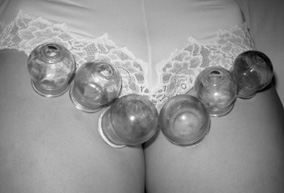
Fig. 12.4 Dry cupping in the groin over the Head’s zone for the uterus and adnexa.
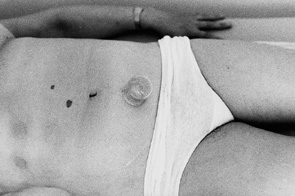
Fig. 12.5 Dry cupping ca. 3 cm below the navel; influencing a disrupted menstrual cycle.
• Carry out two treatments per week, to a total of 15 cupping treatments.
• To stabilize results, follow up with one cupping treatment in intervals of 3 weeks.
• Afterwards, carry out one treatment per month if necessary.
 In hypertonicity, additionally also wet cupping (see Chapter 6).
In hypertonicity, additionally also wet cupping (see Chapter 6).
Supplemental Therapy
• Homeopathy. The time of menopause affects women in every aspect of their existence. Different symptoms appear in this transitional stage, manifesting on the physical, emotional, and mental level. From a homeopathic perspective, it is not the individual symptom that points to the correct choice of remedies in these disorders, but the potential total of all symptoms. Choice of individual remedies according to homeopathic principles, as important supplemental therapy.
• Phytotherapy. For patients with depressed mood swings and nervous irritability, extracts of hypericum, passiflora, or hops. The last of these has a sedative and an estrogenic effect.
Alternating Therapy
• Neural therapy. Quaddle therapy with local anesthetics on top of the ventral Head’s zones of the lower abdomen and on top of the sacrum.
• Canthardin plasters. Therapy in cases with imminent hypertonicity.
• Baunscheidt therapy. Paravertebral treatment in segment L5.
• Autohemotherapy. Can be useful.
Sexual Malfunctions in Women
The course of women’s sexual lives is not always free of obstacles. On the contrary, it can be disturbed on multiple levels.
The most common malfunctions are caused by psychological strain, as a result of which many women are no longer able to feel the natural sexual urge, let alone sexual climax. These psychologically stressful factors include: unconscious negative attitude toward sexuality as a result of upbringing; fright; uncomfortable sexual experience (sexual abuse); extramarital affairs. The partner’s irresponsible behavior can also trigger sexual malfunctions or even aversion to the partner, and extinguish sexual feelings in the woman altogether.
Sexual malfunctions and deviations associated with sexual life include the following:
• Complete lack of desire for sex (libido).
• Absence of the ability to achieve orgasm during sexual intercourse (anorgasmia or frigidity).
• Inability of the woman to orgasm during sexual intercourse at the same time as her partner (dyspareunia).
Dysfunctions of the sexual act and of sexual satisfaction are nowadays found in a surprisingly high percentage of women.
The complete absence of desire for sexual contact is pathological and often conditioned by physical factors. Possible causes are underdevelopment of the genital organs, serious general illness, disorders of the central nervous system, etc.
The absence of orgasm is one of the states of sexual inability, similar to impotence in men. The basic difference is that men are unable to have sexual intercourse in the state of sexual impotence, while women (in the state of complete absence of orgasm) with rare exceptions are almost always still able to have sexual intercourse. Anorgasmia can have physical as well as psychological causes: sensory disorders with a physical basis have causes both in the area of the genitalia, for example, infections, vaginal stricture, and so on, and in serious general diseases, fatigue from one’s work or lifestyle, deficient or wrong nutrition, and the effect of certain medicinal drugs.
Because women by nature need more time than men to orgasm, simultaneous satisfaction is not always guaranteed for them. If the man reaches a satisfying climax at the very beginning of sexual intercourse, the fault for this does not lie with the woman, but also with the man. A real deviation exists when the woman requires an unnaturally long period of time to achieve an orgasm. Women who suffer from sexual malfunction require as much affection and understanding as impotent men to reach an unforced and natural, sexually relaxing feeling of sensuality.
As a rule, sexual malfunctions appear in conjunction with other indications of vegetative dysregulation, such as poor circulation, weak concentration, palpitations, and so on.
After structural causes have been eliminated, repeated cupping can attempt to influence the genitalia and rebalance vegetative dysregulation.
Suggested Therapy
The following formula has proven effective for treatment:
• Initially, two to three treatments per week, to a total of 18 treatments.
• Afterwards, you can increase intervals between treatments initially to 2 weeks, later to 4 weeks, depending on success.
Stay updated, free articles. Join our Telegram channel

Full access? Get Clinical Tree


